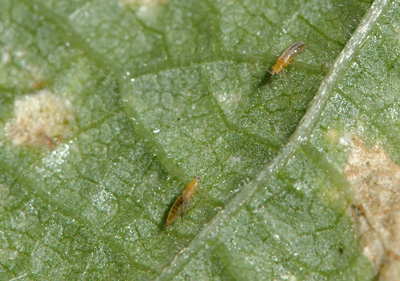Talking Plants
Jillian Patrie | University of Minnesota Yard and Garden Extension
Thrips are out and about this summer and can cause trouble in the garden when populations begin to increase. Let’s look at best management practices and what to look for when dealing with thrips in the landscape.
Thrips are narrow, about 1mm long and yellow or dark brown in color. Thrip eggs are deposited directly into plant tissue and are not detectable with the naked eye. Damage to plant parts is commonly characterized by the silver scarred appearance left behind by thrips feeding on cell fluids within the plant tissue. Hot weather increases thrip populations dramatically, taking only 12 days for thrips to complete their life cycle.
Why are thrips an issue? Thrips like to feed on young immature flowers and buds causing them to fall off or become deformed. This can cause deformed fruit or no fruit to form if flowers fall off before opening. Thrip feeding will also cause flower petals to “lose” their color, making them less attractive. Thrips can transmit tospoviruses and cause plant viruses like tomato spotted wilt.
Controlling thrips can be a challenge because they are usually tucked away, feeding deep within flowers and buds and can be missed with insecticide sprays. Washing with a strong stream of water can knock thrips off plant tissue, other options are utilizing naturally occurring predatory or beneficial insects. Green lacewings, minute pirate bugs, and some parasitic wasps are examples of natural thrips enemies. Other management controls include neem oils, insecticidal soaps and pyrethrins. However, these management practices are more effective in indoor settings and thrips can become resistant to insecticide products.
Cultural controls are more likely to be effective management strategies for outdoor landscapes and garden plants. Avoid weedy areas or grasslands that can be alternative hosts for thrip life cycles. Planting “trap crops” like carrots or chrysanthemums can keep them away from other crops. Remove spent flowers, as these can become homes for thrips. Row covers with fine mesh can be added to vegetable gardens to exclude female thrips from laying eggs on plant tissue.
For more information on thrips and control methods visit https://apps.extension.umn.edu/garden/diagnose/insect/indoor/flies/small/thrips.html. For more information on common garden pests visit https://extension.umn.edu/vegetables/common-insects-vegetable-crops.
For questions about this article or local assistance please contact Clay County Extension Educator, Jill Patrie at 218-299-7338 or by email at patri350@umn.edu.


